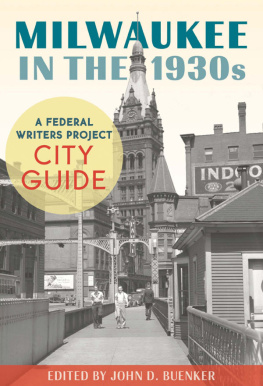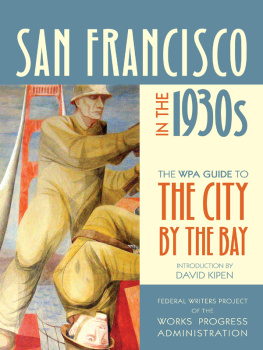IDAHO
A Guide in Word and Picture
The WPA Guide to Idaho
The Gem State

Trinity University Press
San Antonio
Published in 2014 by Trinity University Press
San Antonio, Texas 78212
www.tupress.org
This book was first published as part of the Works Progress Administrations Federal Writers Project, a United States federal government project to fund written work and support writers during the Great Depression. It has been published in various editions, but this edition replicates the original. Trinity University Press is proud to make these books available through the WPA Guides to America Digital Library.
978-1-59534-210-2 ebook
TO ALL IDAHOANS WHO HELPED TO MAKE IT,
THIS BOOK IS DEDICATED

Foreword to the First Edition
G ETTING out a book of this sort proved to be an unusually difficult task because on so many matters, such as flora and fauna, there was little published information, and on still other matters much of what had been published was inaccurate. It is quite beyond reason to expect that no inaccuracies exist herein, but it is hoped that the number is few. In some instances statements may be challenged by persons who are unaware that a good many of the traditional notions about Idaho are not supported by fact.
To the hundreds of Idahoans who gave willingly of their information and time, acknowledgment is now made, and it is regretted that their names cannot be appropriately recorded here. The Guide is indebted more especially to Harry Shellworth, Ben Oppenheim, Ansgar Johnson, and Dr. A. E. Weaver for their assistance in many matters; to members of the University faculties at both Moscow and Pocatello for their reading of certain chapters; to the supervisors of all the National Forests of the State for their willing aid; and above all to M. S. Benedict, whose generosity in placing his skill as a photographer at the service of Idaho knew no limits. The Pocatello copy was written by businessmen of that city, and the two essays on Indians by Ruth E. Lyon.

Foreword to the Second Edition
S INCE this book was written, a dozen years have been measured by the clock. The clock, perhaps new twelve years ago, has yielded to that constant call of change and rhythm of snows, of springs, of summers and autumns; so too, I view the thousands of articles, facts, and figures between the covers of this book, which set forth Idaho as a magic wonderland, as in need of some repair.
To this end, new facts and figures have been set down to supplant those of another day as they are found and exist at this moment. To those intending to visit this State, or to those who wish to explore their native commonwealth and wonderland for the first time, this guide is indispensable. For no State is on the threshold of such a vast development, no State offers a greater choice of climate, occupations, or resources than Idaho does, the State of wide open spaces, of deserts and fruitful valleys, with the sunlight coming down its forest-covered mountains.
On the walls of the Hulbert Sorority of Leland Stanford, I once read this inscription, which reminds me so much of Idaho:
Be glad of life because it gives you the chance to love and to work and play, and to look up at the stars. Spend as much time as you can with body and with spirit in Gods out-of-doors.
J. D. PRICE
Secretary of State

Contents

Illustrations



A FTER three centuries of adventurous seeking, the American continent has been explored and settled, and the last frontier is gone. The lusty and profane extremes of it still live nebulously in the gaudy imbecilities of newsstand pulp magazines and in cheap novels, wherein to appease the hunger of human beings for drama and spectacle, heroines distressingly invulnerable are fought over by villains and heroes and restored to their rich properties of mine or cattle ranch; the villain, if left unslain, passes out of the story sulking darkly; and the hero, without cracking a smile, stands up with the heroine clinging to his breast and addresses the reader with platitudes that would slay any ordinary man. But these villains with their Wild Bill mustaches, these apple-cheeked heroines agog with virtue, and these broad adolescent heroes who say gosh ding it and shoot with deadly accuracy from either hand are remote in both temper and character from the persons who built the West. They are shoddy sawdust counterfeits who would have been as much out of place in the old West as Chief Nampuh with his huge feet would have been among the theatrical ineptitudes of a Victorian tea.
It is a little strange, therefore, that many of the recent books about frontiersmen have been so painstakingly off the track. It is unfortunate that opinion runs to one of two extremes. There are, on the one hand, those writers who declare solemnly that the men and women who moved westward, conquering the last reaches of wilderness and danger, were either morons who had no notion of what they were doing or low-browed rascals fleeing from the law. Those who argue, as some have, that the frontiers were settled largely by vagrant shysters must be overwhelmed by distaste for their own anemic and stultified lives, and doubtless seek through perversity a restoration of their self-esteem. Nor is the matter improved, on the other hand, by those who, lost in glorification of ancestors, declare that nearly all of the pioneers were lords of foresight and courage, shepherded by wives whose gaze was everlastingly full of visions. The fable here is especially absurd when these writers are themselves the sons and daughters or the grandchildren of the pioneers.
Most happily, as a matter of fact, the frontiers were conquered by neither saint nor villain. The men and women who pushed by thousands into the West were quite like the people of this generation from whom all physical frontiers have been taken. A few of the old-timers came because they were unusually adventurous in spirit; a larger number came because they were shoved out to new anchors by privation and want; and others came as crusaders to preach the particular creeds by which they were trying to live. It is quite pointless for us today to extol those generations that moved westward, laying resources to waste or building their empires: they were neither villain nor hero except in the way that any person may be when driven to face a frontier and to try to find a meaning in it. They were not, with rare exceptions, even aware that they were laying the foundations for the future of a huge territory: they were trying to make a living, to survive, quite as these are the matters engaging the wits and energies of those who have come after them. And it is equally pointless to call them marauders and thieves: in a primitive struggle to survive there is no time for amenities. The men and women who blazed the trails and built forts and laid open the mines and the forests had zest and vitality, and there are no virtues more indispensable than those.
Next page







